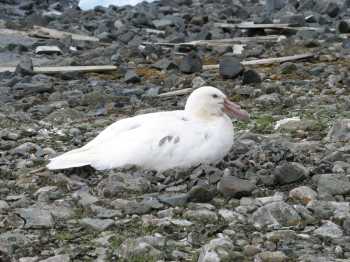Christina Braun (Polar & Bird Ecology Group, Institute of Ecology, University of Jena, Germany) and colleagues have published this year in the open-access journal Polar Research on the impacts of human activities in the Fildes Region of King George Island, South Shetland Islands in the Antarctic Peninsula region, including on ACAP-listed Southern Giant Petrels Macronectes giganteus.
They report that "[t]he current rapid decrease in southern giant petrel breeding pair numbers and breeding success at some breeding sites is unlikely to be attributable solely to environmental conditions (e.g., food availability, climatic conditions, predation) as adjacent colonies which should be subject to the same natural factors were unequally affected. Human disturbance seems to be the immediate reason for these observed changes since only areas which are frequently visited during summer by station members in their leisure time showed greater declines."
The paper's abstract follows:
"The Antarctic terrestrial environment is under increasing pressure from human activities. The Fildes Region is characterized by high biodiversity, but is also a major logistic centre for the northern Antarctic Peninsula. Different interests, from scientific research, nature conservation, protection of geological and historical values, station operations, transport logistics and tourism, regularly overlap in space and time. This has led to increasing conflict among the multiple uses of the region and breaches of the legal requirements for environmental protection that apply in the area. The aim of this study was to assess the impacts of human activities in the Fildes Region by monitoring the distribution of bird and seal breeding sites and recording human activities and their associated environmental impacts. Data from an initial monitoring period 2003-06 were compared with data from 2008-10. We observed similar or increased levels of air, land and ship traffic, but fewer violations of overflight limits near Antarctic Specially Protected Area No. 150 Ardley Island. Open waste dumping and oil contamination are still major environmental impacts. Scientific and outdoor leisure activities undertaken by station personnel are more frequent than tourist activities and are likely to have a commensurate level of environmental impact. Despite the initial success of some existing management measures, it is essential that scientific and environmental values continue to be safeguarded, otherwise environmental impacts will increase and the habitat will be further degraded. We argue that the Fildes Region should be considered for designation as an Antarctic Specially Managed Area, a measure that has proven effective for environmental management of vulnerable areas of the Antarctic."

White-phase Southern Giant Petrel breeding on King George Island
Photograph by Markus Ritz
Reference:
Braun, C., Mustafa, O, Nordt, A., Pfeiffer, S. & Peter, H.-U. 2012. Environmental monitoring and management proposals for the Fildes Region, King George Island, Antarctica. Polar Research 31. http://dx.doi.org/10.3402/polar.v31i0.18206.
John Cooper, ACAP Information Officer, 9 June 2012

 English
English  Français
Français  Español
Español